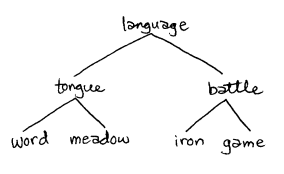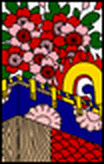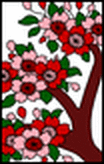![[Home]](https://ludism.org/logo/beads.gif)
This is a sample game for the KenningHaikuCompetition. The page KenningHaiku has explicit rules for making kenning haiku.
This kenning haiku is called the Norse Language Game because it uses Norse kennings to illuminate the meaning of the term "language".
The HelloWorldGame was initially intended to be the introductory kenning haiku. However, it became too elaborate for that, and a new introductory game was needed. The basics for this game were sketched out in about half an hour with actual Norse kennings drawn from less than 25 pages of the Younger Edda. You can see the KenningTree?, or outline of the game, in the following diagram:

language battle
-------- :: ------
tongues swords
language = tongue battle
tongue = language sword
battle = sword language
sword = battle tongue
Every kenning game has its own flavour. Using genuine medieval Norse kennings, as opposed to kennings implicit in world culture (compare the HelloWorldGame), makes this game Viking-flavoured.
When using actual Norse kennings, violent imagery is hard to avoid. In this case, not only does the primary kenning equate language with battle, but, unfortunately, the larger context refers to the conquest of Norway as the rape of a woman. ("Lures under himself" might refer to seduction, but in the context of battle, rape is clearly implied.)
The term "tongues" is only implicit in the kenning "battle is the language of swords". (The next two kennings are explicit, rather than derived indirectly.) "Words" is another possibility for the missing fourth term of the kenning analogy, but "tongue" is a synonym for "language" in English and other languages, and I suggest that if swords are battle-tongues, then their words are thrusts and parries.
Imagine swords extending from speakers' mouths and clashing in swordplay. This is language.
tongue meadow
------ :: ------
word flower
tongue = word meadow
word = tongue flower
meadow = flower tongue
flower = meadow word
The imagery of words or texts as flowers occurs outside Norse mythology as well. For example, in Pure Land Buddhist mythology, the flowers of heaven sing Buddhist doctrine.
"Word-meadow" for "tongue" is an explicit kenning, unlike the first kenning in this game, which is implicit.
Imagine a broad pink meadow, covered with white tufts, each a word, that float away in the wind like dandelion seeds. This is a tongue.
battle game
------ :: ----
iron card
battle = iron game
iron = battle card
game = card battle
card = game iron
"Card" was chosen as the missing term in the kenning analogy, the equivalent to iron, because not only is card a material, as iron is, but "card", in the singular -- "a card" -- is an implement with which one plays a game, as "an iron" ("a big iron on his hip") is a weapon with which one fights a battle. An iron is made of iron, and a card is made of card.
"Iron-game" for "battle" is another explicit kenning.
Imagine a game played with playing cards that are made of iron, with razor-sharp edges. Players whirl these at one another like shurikens. This is battle.
Hanafuda, sometimes called "War of Flowers", is a Japanese card game system.




(Hanafuda card graphics from Flowersol, licensed under the GNU GPL.)
Here are three good Hanafuda information sites:
language = (tongue battle)
tongue = (word meadow)
battle = (iron game)
language = ((word meadow) (iron game))
The use of flowers as weapons is reminiscent of the fantasy of Jorge Luis Borges. Borges was obsessed with language, and Gene Wolfe is obsessed with Borges. Thus, it's appropriate that flowery combat is an metaphor for language in this game, even though it is probably not what Wolfe intended.
Note that the quotation in this section uses graphic elements and hypertext links. Not all quotations need to be textual; even audio, video, and interactive quotations are possible.
Imagine swords extending from speakers' mouths and clashing in swordplay. This is language.
Imagine a broad pink meadow, covered with white tufts that float away in the wind like dandelion seeds. This is a tongue.
Imagine a game played with playing cards that are made of iron, with razor-sharp edges. Players whirl these at one another like shurikens. This is battle.
Imagine two broad pink meadows on a hill. Each meadow shoots razor-sharp, shuriken-like iron playing cards depicting flowers at the other. This is language.
Language = battle of tongues = iron game of word meadows.
--Ron_Hale-Evans?